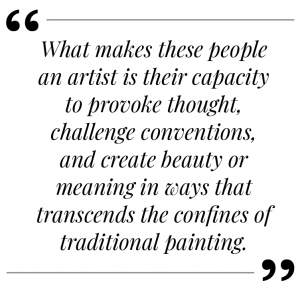 ART HAS always been a fascinating realm of human expression, where creativity and imagination thrive. Many might raise their eyebrows at this notion, but it holds true. What does it mean? It suggests that not all painters can be classified as artists, likewise conversely, we encounter individuals who are undoubtedly artists but do not wield a paintbrush. To grasp this concept, we must first define art and differentiate between a painter and an artist.
ART HAS always been a fascinating realm of human expression, where creativity and imagination thrive. Many might raise their eyebrows at this notion, but it holds true. What does it mean? It suggests that not all painters can be classified as artists, likewise conversely, we encounter individuals who are undoubtedly artists but do not wield a paintbrush. To grasp this concept, we must first define art and differentiate between a painter and an artist.
Art is generally characterized as the expression of an idea or the application of human creative skill and imagination, resulting in the creation of beauty and evoking emotional responses upon which art is built. At the core, it all boils down to the act of creating something meaningful, something that provokes the thinking mind, disturbs or relaxes the emotion, or vibrates with contents emanating from the human experience. The essence of art is not limited to a single medium or technique but rather it is spread throughout a wide scope of forms, each possessing its own distinct concepts and characteristics.
The interchangeable usage of the terms ‘painter’ and ‘artist’ contributes to the confusion. However, recognizing this distinction is essential for understanding the depth and diversity of artistic expression.
A painter, as defined, is a person who engages in the craft of applying paint to various surfaces, most commonly over a canvas or a wall, with the aim of creating visual imagery or conveying a message. No doubt, painters are accomplished artisans who excel in the mastery of paint techniques, styles, and the theory of colors. However, it’s important to recognize that not all painters extend their practice into the realm of artistry. Some painters primarily focus their work on the faithful replication of existing images, portraying realism with precision. Their work often revolves around the meticulous reproduction from photos or the precise representation of the physical world. While this demands exceptional technical skills, it may lack the transformative quality that characterizes a wider idea of art.
On the other side of the fence, we see people who are undoubtedly artists but do not hold a paintbrush. Artists are those who possess the extraordinary ability to express their innermost thoughts, emotions, and ideas into a myriad of creative forms such as sculpture, music, dance, literature, performance, digital media, poetry and countless others. What makes these people an artist is their capacity to provoke thought, challenge conventions, and create beauty or meaning in ways that transcends the confines of traditional painting.
One of the key factors that sets artists apart from mere painters is their deep reliance on imagination and emotion. Artists, regardless of their chosen medium, engage in the act of conceptualizing an idea. They dive deep into every corner of their hearts and mind, pulling out raw ideas and intangible feelings and emotions. It is through this process of inner exploration that they breathe life into their creations. Artists envision, experiment, and push boundaries to craft unique narratives or visual experiences. It’s this exercise of the imagination that distinguishes them as artists.
To better illustrate this distinction, one can turn to the works of renowned figures such as this american abstract expressionist Paul Jackson Pollock who was well known in the 1950s for his drip painting technique of pouring or splashing household paint over a horizontal surface. Jackson became a celebrity because of his visionary contribution to the art world. He did not restrict himself to mere replication. He ventured into an uncharted territory of abstraction.
In the vast realm of art, not all painters are artists, and not all artists are painters. The term ‘artist’ encompasses a rich tapestry of creative individuals who work across a multitude of mediums, each with its own unique language. From sculptors and musicians to writers and performance artists, the world of art is diverse and inclusive. The ‘artist’ title is not limited to any specific medium or technique but rather reserved for those who possess the extraordinary ability to transcend the ordinary and take us on a journey through their imagination and emotions.
In conclusion, the distinction between painters and artists is essential for appreciating the multifaceted world of art. While painters master the craft of applying paint to a canvas, artists transcend this medium to evoke emotions, challenge conventions, and provoke thoughts. In the real world, such depictions don’t exist, but they exist in the artists’ mind. The essence of art lies not in the tools used but in the transformative power of the human imagination and the depth of emotion it can convey. Understanding this distinction enriches our perception of art and broadens our horizons as we explore the boundless possibilities of creative expression.
So the next time you encounter a beautiful or controversial painting, the first question to ask should be: Is this a work of a painter or an artist?
